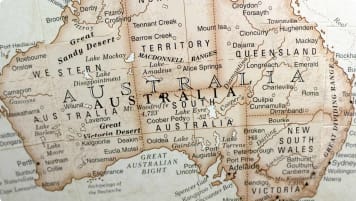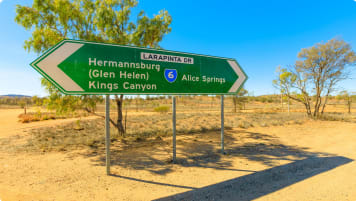Darwin, Northern Territory
Discover Australia's Northern city whilst on a small group package tour to the Northern Territory with likeminded mature and senior travellers couples or singles. Darwin is the base for a tour of Kakadu and Arnhem land.
25 Jun 20 · 6 mins read

Darwin, Northern Territory
Australia ‘s only tropical capital, laid-back Darwin melds European, Asian, and Aboriginal influences into a vibrant stew. Famous for beautiful sunsets and colourful characters along Darwin’s cosmopolitan foreshore up here in Northern Australia.
The traditional owners of the land around Darwin are the Larrakia Aboriginal people. Like Aboriginal peoples elsewhere, the Larrakia cared for the land that surrounded them, mosaic burning grass during the dry in order to make resources abundant. They fished, hunted, and gathered local fruits and vegetables. While the Bininj/Mungguy of Kakadu and the Yolngu of Arnhem Land recognised six seasons, the Larrakia understood their ecosystem in terms of seven overlapping seasons:
- Balnba (rainy season): November- December
- Dalay (monsoon season): January-March
- Mayilema (speargrass, Magpie Goose egg and knock ‘em down season): March-April
- Damibila (Barramundi and bush fruit time): April-June
- Dinidjanggama (heavy dew time): June-August
- Gurrulwa (big wind time): July-September
- Dalirrgang (the build-up): September- October
The first European to see Darwin Harbour was John Stokes, the surveyor aboard the Ship HMS Beagle. This vessel was then circumnavigating Australia on its Third Voyage (1837-1843). Commander John Clements Wickham was reminded of his famous shipmate, the naturalist and geologist Charles Darwin (who had accompanied them on their Second Voyage around South America, New Zealand, Australia and western Africa), and named the harbour ‘Darwin Harbour‘.

The government was keen to establish a settlement in the Top End, to prevent foreign occupation and establish a ‘New Singapore’, a trading post for the British Empire. After three failed attempts – including Victoria in Arnhem Land – a settlement, known as Palmerston (after Viscount Palmerston, the Prime Minister of Great Britain) was established in 1869 on Darwin Harbour. Palmerston was renamed Darwin in 1911.
The new settlement saw the arrival of the Overland Telegraph Line, following a route established by John McDouall Stuart in 1872. Around this time, gold was discovered at Pine Creek, drawing settlers from around Australia and a number of Chinese migrants, many of whom form part of Darwin’s population today.
During World War II, Darwin was the front line against Japanese expansion in the Pacific. It was severely bombed by the Japanese in 1942 – the only Australian city to see bombing – killing hundreds. The extent of the damage was kept secret from the Australian population, in order to better keep up morale.
On Christmas Eve 1974, Darwin was devastated by Cyclone Tracey. 71 people died, 70% of buildings were destroyed (including 80% of houses), and more than 25, 000 people (out of 47, 000 people) were made homeless. 30,000 were evacuated from the city, many never to return. The city was totally rebuilt in the aftermath of the cyclone.
Today, Darwin has a population of around 148,564, the smallest of Australia’s capitals. Closer to Bali than Sydney, the city is home to over 50 nationalities, and has an Aboriginal population of 8.7%, by far the largest of any capital city.
Things to see in Darwin:
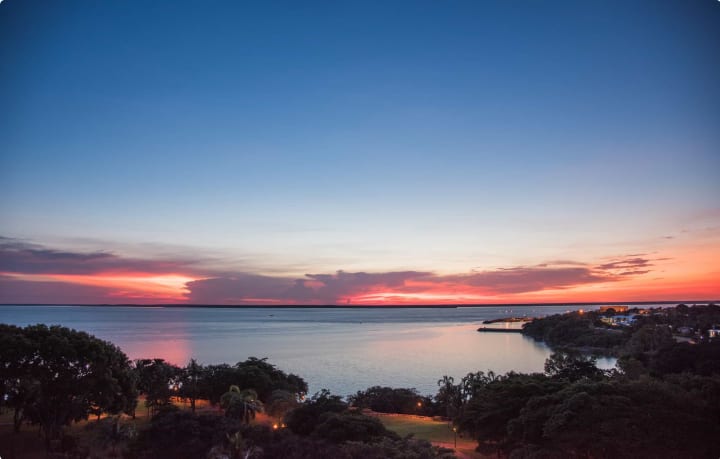
Locals like to say that “If you don’t like sunsets and markets, you won’t like Darwin.” The city is marked by extraordinary sunsets, vivid skies of orange, pink and purples, flanked by palm trees. The sunsets are best viewed from Darwin’s beaches – Mindil Beach, Nightcliff Foreshore, Cullen Bay and Fannie Bay – or on a sunset cruise around Darwin Harbour.
As for markets, the decisive winner here is Mindil Beach Sunset Market. From Thursday to Sunday, around half of Darwin congregates on this vibrant beachside market. Over 200 speciality stores offer cuisines from around the world, while arts and crafts stalls sell Aboriginal artefacts, pieces from Indonesia and Malaysia, and local artisan wares. Similar markets are found around suburban Darwin on the weekends.
However, we might have to disagree with the locals: Darwin has plenty to offer, even for those who can take or leave the markets and the sunsets. The Museum and Art Gallery of the Northern Territory is home to an extensive collection of Aboriginal art, including pieces from the Tiwi Islands, bark paintings from Arnhem Land, and dot paintings from the desert. An entire room is devoted to the history of Cyclone Tracey, including an interactive exhibition where you can listen to the whirring sound of the approaching cyclone. The Maritime Gallery collects sea vessels from Indonesia, Malaysia, Vietnam, Papua New Guinea, the Solomon Islands, Fiji, Cocos and Keeling Islands, showing the entwined histories of South-East Asia and the Pacific.
Unfortunately, thanks to Japanese bombing and Cyclone Tracey, Darwin is light on historic buildings. The Fannie Bay Gaol, the Northern Territory’s main prison from 1883 to 1979 is now a fascinating historic site. Lyon Cottage, built in 1925, is Darwin’s only remaining colonial bungalow. It is now managed by the Museum and Art Gallery, and currently houses Aboriginal Bush Traders, an Aboriginal art gallery, store, and bush foods cafe. Government House, built 1869, was the first ‘grand’ public building constructed after settlement; while Brown’s Mart, dating back to the 1880s, is now a community theatre that has been a centre of the arts for over 40 years. The National Trust-listed Burnett House, built 1939, is the only surviving example of Beni Car Glynn Burnett’s Type ‘K’ architecture, a radical structure designed to be suitable for the tropical weather.
Darwin also has an number of fascinating sites for those with an interest in military history, particularly World War Two. The Defence of Darwin Experience, opened in 2012 as part of 70th anniversary commemorations of the bombing of Darwin, is a powerful exhibition delving into the 1942 bombing, while the next door Darwin Military Museum collects objects from all conflicts in which Australia was involved. The Darwin Aviation Museum has a giant B52 bomber, only one of two outside the United States, and a Japanese Zero fighter, shot down in World War Two.

WW2 sites dot the city, including the Sandy Creek Observation Post at the Casuarina Coastal Reserve, built to allow a clear view of approaches from sea; while remains of a WW2 military base can be seen along the Stuart Highway. The Navy Victualling Yards were vital to the logistics and supply requirements of the army, navy, and air force personnel stationed in Darwin during the war. The Adelaide River War Cemetery shows the impact of war on Darwin, while the nearby civil cemetery honours the civilians killed in the 1942 bombing.
The Oil Storage Tunnels, located on Darwin Wharf, were built in World War II by the Civil Construction Corps to protect the Darwin’s oil supplies from the Japanese. Today, the tunnels – lined with photographs and other information from Darwin’s war experience – take visitors deep under the city.
Charles Darwin National Park, on the southern edge of Darwin, is noted for its collection of World War II bunkers, one of which has been converted into a visitors centre and museum. The park also has a long Aboriginal history, with shell middens indicating that the Larrakia people have lived in the park for thousands of years.
Charles Darwin National Park also encloses Port Darwin wetland, an important ecosystem home to 36 out of the Northern Territory’s total 51 species of mangrove.
Odyssey Traveller visits Darwin city as part of our tour of Kakadu National Park and Northern Australia, one of our new outback and Australia tours. Designed to go beyond your typical Kakadu day tour, our guided tour spends six nights in lodge accommodation in Jabiru, so that you can make the most out of your time in Kakadu.
Australia‘s largest national park, Kakadu is a place of diverse ecosystems, ranging from the sandstone escarpments of the Arnhem Land escarpment, to wetlands, tidal flats, and monsoon forests. Our trip takes in the park‘s most spectacular scenery, including the stunning waterfalls of the Gundun Plunge Pool and Waterfall Creek. We take a Yellow Water Cruise on the Yellow Water Billabong to see Kakadu’s extraordinary wildlife. Kakadu is home to a third of Australia‘s bird species, including an array of migratory birds, and a number of threatened species of animal and plant. On our wildlife cruise, we will see magpie geese and the saltwater crocodile in their natural habitat!
We also take the time to learn about the vibrant indigenous culture of Kakadu, exploring ancient Aboriginal rock art and archaeological sites at Nourlangie Rock and Ubirr Rock. Kakadu is managed today according to traditional Aboriginal land practices, including seasonal burning to prevent bush fires.
Our Kakadu tour also takes us to Arnhem Land, a place of natural beauty and stronghold of traditional Aboriginal culture; to the Fogg River Conservation Reserve in the Mary River Wetlands; and on a day trip to Litchfield National Park. On our Litchfield tour, we visit the Buley Rockhole, one of the Northern Territory‘s most popular swimming holes, and walk among the strange termite mounds found around the park.
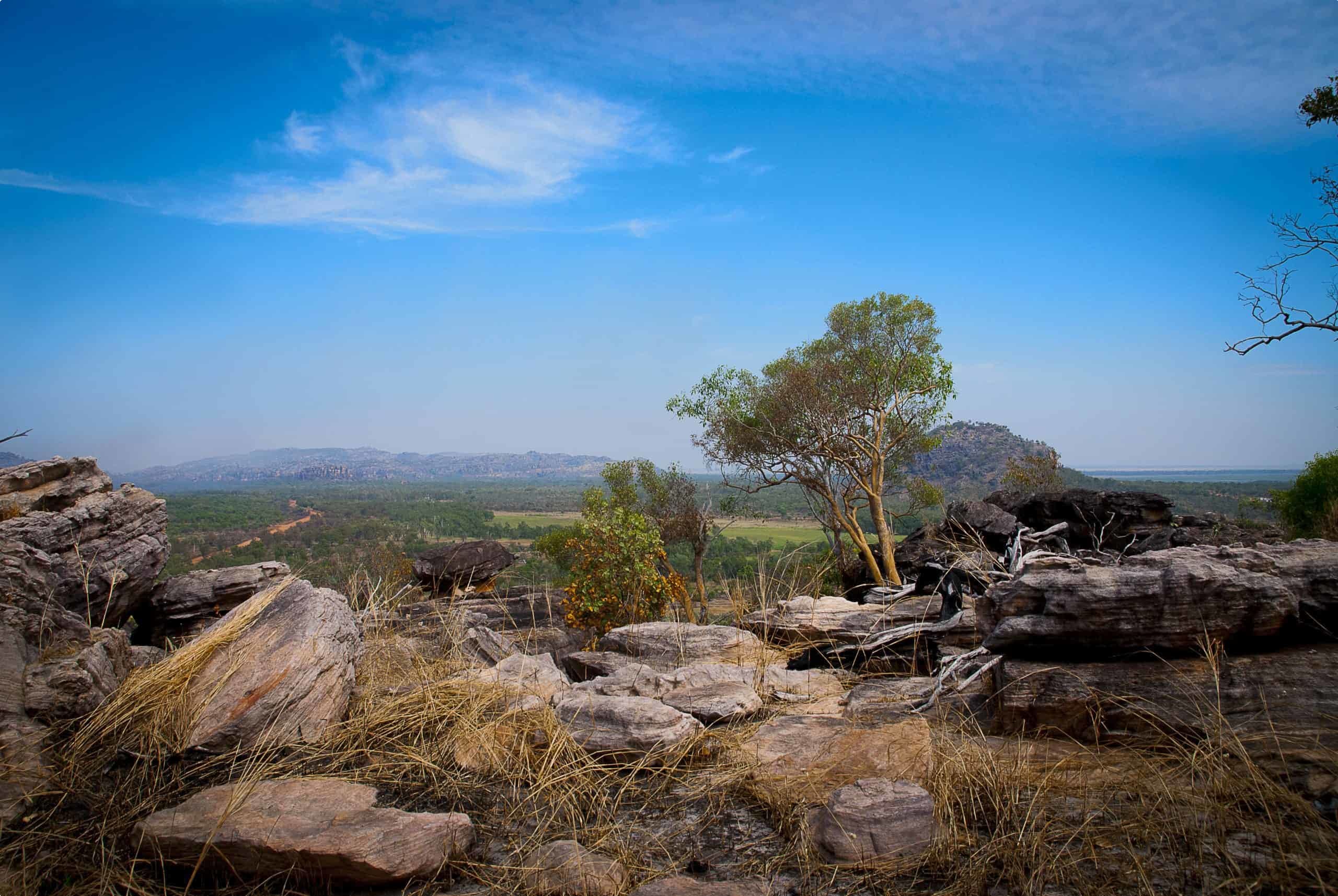
Articles about Australia published by Odyssey Traveller:
- The Kimberley: A Definitive Guide
- Uncovering the Ancient History of Aboriginal Australia
- Aboriginal Land Use in the Mallee
- Understanding Aboriginal Aquaculture
- Mallee and Mulga: Two Iconic and Typically Inland Australian Plant Communities (By Dr. Sandy Scott).
- The Australian Outback: A Definitive Guide
For all the articles Odyssey Traveller has published for mature aged and senior travellers, click through on this link.
External articles to assist you on your visit to Australia:
Selected small group package Tours of Australia

days
Jun, Jul, Sep, Feb, Mar +1Darwin and Kakadu small group tour
Visiting Northern Territory
Explore and learn as part of a small group tour for seniors on this package tour to Darwin and Kakadu National park, a UNESCO world heritage site. This program also visits Arnhem land. Our focus is on ecology, landscapes and history on this 14 day program in the far north of the Northern Territory.

14 days
May, Jun, Jul, Aug, SepSmall group tour of Australia's Kimberley
Visiting Western Australia
Escorted small group tour of the Kimberley. We explore and visit The Bungles, Bell Gorge, Mitchell plateau & Halls Creek in the dry season. Amazing landscapes intertwined with Aboriginal communities resident more than 45,000 years.
From A$15,390 AUD
View Tour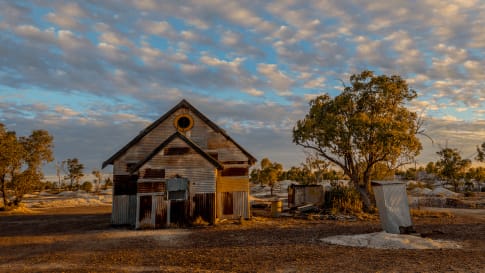
days
Mar, Apr, May, Jul, Aug +2Small group tour of outback Queensland
Visiting New South Wales, Queensland
To Dubbo and back, this small group tour takes you to learn about the Brewarrina fish traps, we travel high up into North Queensland to see the Dinosaurs of Winton and incredible Aboriginal rock art at Cathedral gorge and learn about opal mining and the history of Lightning ridge.
Articles

Aboriginal history and culture of Kakadu National Park, Northern Territory
For those seek to learn as they travel then the history of the Aboriginal journey and timelines that unfold as a discovery in Australia seek to fascinate the mature and senior traveller on a small group package tour for couples and singles. From Darwin, this tour also visits Arnhem land as well as Kakadu, during the dry season.

Aboriginal Rock Art in the Kimberley, Australia
The Kimberley is explored on a small group tour for mature and senior travelers, couples or singles. Both Aboriginal community is studied and an appreciation of the wet and dry seasons. This guide on the Kimberley assists the traveler as you start from Broome and travel round via Halls creek and Purnunulu national park over some 17 days in a group of up to 12 people.

Aboriginal Sites of Importance in Outback Queensland, Australia
Outback Queensland is hiding a number of unforgettable indigenous experiences on this small group tour for senior travellers. Especially at the Brewarrina Fish Traps, and Carnarvon Gorge, for example where you can experience and learn about dreamtime creation stories, age-old cultural practices and traditions, and Aboriginal art.
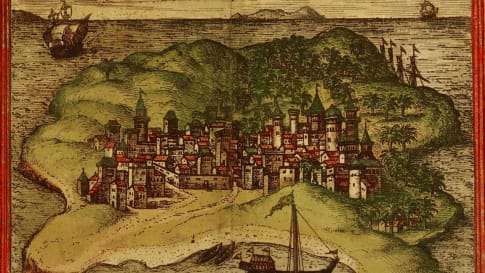
Archaeological mysteries of Australia: How did a 12th century African coin reach Arnhem Land?
Consider the impact of Portuguese, Spanish and Chinese followed by the Dutch trading in the Spice islands to the North of Australia from the 11th century. The probability of African coins reaching a beach become real. Learn more on a small group package tour to Kakadu and Arnhem land or the Kimberley where shipwrecks have been found to consider the impact on Aboriginal history and rock art. Tours for seniors couples and singles.
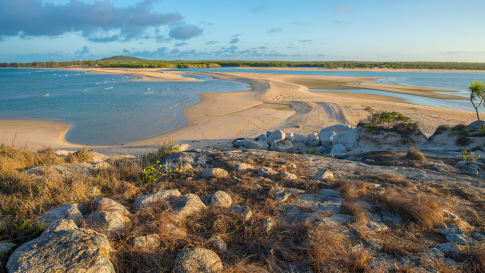
Arnhem Land, Northern Territory
To enter Arnhem land a permit is required for visitors. Explore and learn about the Aboriginal community in Arnhem land as part of a small group package tour that includes Darwin and the Kakadu. These are small group tours of upto 12 like minded mature and senior travellers, couples or solo travellers interested in exploring as they tour.

Lake Argyle, Australia
Understand why Lake Argyle exists before joining a small group package tour for mature and senior travellers of Western Australia's Kimberley region in the preferred dry season. Limited to 12 travellers for your peace of mind we learn about the landscapes and the aboriginal stories often via the rock art in far North.

Natural landscapes of Kakadu National Park, Northern Territory
Article about a unique RAMSAR landscape and UNESCO world heritage site explored and part of a small group tour for mature and senior travellers couples and singles based in Darwin. Landscape, wildlife, and aboriginal history and settlement plus African mystery are part of this and other articles on Kakadu.

The Australian Outback: A Definitive Guide
Explore learn and consider what is the outback in this article. For mature and senior travelers considering joining a small group package tours into the outback to see, learn and explore about this unique place, not only the landscape but the Aboriginal approach to living. On each of the tours for couples and the single traveler you learn something different but fascinating, from Outback Queensland, the Flinders, Broken Hill and the Kimberley and the wildflowers all contribute to this question, what is the outback?
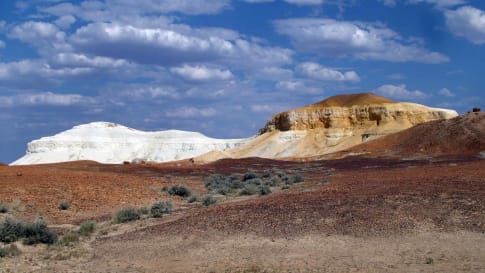
The Kimberley: A Definitive Guide
This article supports the small group package tours for mature and senior travellers, couples and solo travellers to Western Australia's Kimberley region. Learn about the wet and dry seasons and the fascinating Aboriginal history as well as the Bungle Bungles, Lake Argyle, Halls creek and resort of Broome.
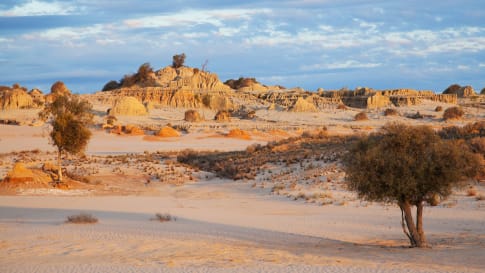
Uncovering the ancient history of Aboriginal Australia
For small group escorted tours of Australia in Queensland, Victoria, New South Wales, South Australia, Tasmania, Western Australia and the Northern Territory a guide on Aboriginal culture for mature and senior travellers.
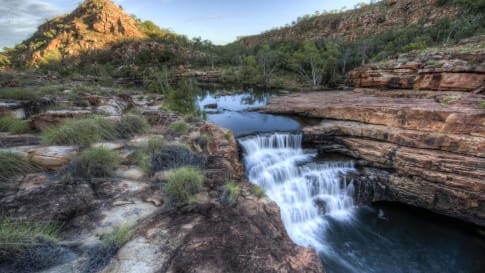
Wet and dry seasons in the Kimberley, Australia
Learn about the wet and dry season in the Kimberley to support your understanding of the Aboriginal communities lifestyle as you explore on a small group package tour for mature and senior travelers exploring as a couple or solo traveller. Read our peace of mind statement for post covid-19 travel.

